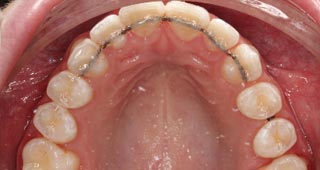Orthodontic appliances
Braces
If you or your child need braces, it's good to know that there are a number of alternatives and advances when compared to 'traditional' metal braces. Braces are more comfortable and easier to maintain than ever before, and there are near invisible options you can now choose from including ceramic braces. "Traditional" stainless steel braces are smaller than ever, and are still usually the most efficient and cost-effective method of aligning teeth.
The wires we use now are often made from newer materials such as copper-nickel-titanium, and they offer excellent flexibility, lower forces and so are much gentler than stainless steel wires.
Ceramic braces are like metal braces, but are made of porcelain, so they are more transparent and tooth coloured, and the braces themselves usually blend in with your teeth and can be close to invisible.

Palatal expansion
Children and teenagers who have crowded teeth due to a narrow maxillary (upper) dental arch, may require some expansion. An expansion appliance is placed on the teeth in the upper jaw to create sufficient spacing. This appliance may be removable (slow maxillary expansion appliance), or it can be cemented in place for more rapid results (rapid maxillary expansion).
While braces are ideal for children over ten years old, palatal expansion is often used a few years earlier while the jaw is still developing. These appliances are often used for three to six months and, depending on the type being used, require daily or weekly adjustment.
Our team keeps a close eye on progress, and after only a few weeks little gaps between the front teeth may be apparent - this the sign that the jaw is expanding correctly! The expander is then left in for a few months to ensure your child is comfortable and the widening remains.
If your child has an expansion appliance and you have any questions or, if you think they may benefit from one, call us on (08) 8945 4844

Rapid Maxillary Expansion

Slow Maxillary Expansion
Removable appliances
Removable appliances may be used to fix simple problems from the age of 6 onwards.
A 'simple problem' may be an anterior cross bite, which is where a top front tooth bites behind the bottom front tooth (ie. the bite is "back to front"). Removable appliances are usually worn for 3-4 months, however compliance is critical to their success. Types of removable appliances may also be used to deter thumb, or finger, sucking.

Crossbite Correction
Retainers
Retainers are used in all patients to hold the teeth in their new position. Teeth are most likely to move in the first 12 months after braces, and while the patient continues to grow.
Retainers can either be fixed or removable. Removable retainers can be made of hard coloured or clear acrylic (Hawley appliance) and look like a plate, or be made of thin heat moulded plastic and look like a thin mouthguard.
A bonded retainer is a thin wire that is fixed and bonded behind the teeth, where it can't be seen. It can remain in place for several years.
Removable retainers need to be worn for 8 to 12 hours a day every day (usually at night) for at least 12 months. Patients will be seen at least once every 6 months.
Over time the retainer wear can be reduced to a few nights a week, before stopping altogether. The longer patients wear retainers, the more stable the result will be in the longer term.


Invisible Retainer

Bonded Retainer
Functional appliances
For children and teenagers with a small lower jaw, functional appliances may benefit their growth, encouraging appropriate positioning and spacing. These devices may be removable and many incorporate an expansion device to increase the width of the jaw.
An example of a functional appliance is a "Clark Twin Block". These encourage forward jaw growth, and aid correcting the positioning of jaw joints. Children are still able to open and close normally making this an extremely well tolerated appliance.
Functional appliances are only suitable for growing children and, while not all growth issues can be corrected with them, sometimes their use can reduce the need for future orthodontic treatment such as braces or jaw surgery.



"Twin Block" functional appliance
Book a
Consultation

See some of our
Beautiful smiles

Fix your smile
Get interactive


